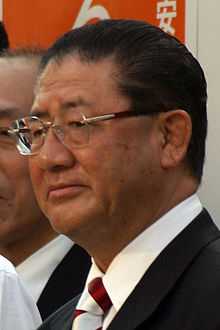Taku Yamasaki

Taku Yamasaki (山崎 拓 Yamasaki Taku, December 11, 1936) is a Japanese politician,[1] a member of the House of Representatives of Japan. Born in Dalian, Manchukuo, he is a graduate of Waseda University. He worked at Bridgestone.
He lost his vision in one eye in childhood.
As a Diet member, he served as Minister of Construction, and Director General of the Defense Agency. He was a member of the "YKK" faction with Kōichi Katō and Jun'ichirō Koizumi. Yamasaki was also the leader of a small faction that bore his name. In November 2000, along with Kōichi Katō, Yamasaki was heavily involved in the failed intraparty coup against Prime Minister Yoshirō Mori. He became Secretary-General of the Liberal Democratic Party in 2001, and the Vice-President of the LDP in 2003.
In the 2003 election Yamasaki was defeated by Jun'ichirō Koga of the Democratic Party. He subsequently resigned from the vice-presidency of the LDP and took on the role of a political advisor.
In 2005, re-elected to the House of Representatives by-election on Fukuoka Prefecture 2nd Electoral District and Chiefship, Special Committee on Postal Privatization.
Possible Koizumi successor
Yamasaki, Shinzō Abe, and Foreign Minister Tarō Asō, were all considered candidates to replace Koizumi after the prime minister's term expired in September 2006. All three are conservative on foreign policy issues and have taken confrontational stances toward other East Asian nations, particularly North Korea and, to a lesser extent, China. Abe is considered a more "moderate" politician than the more "hard-line" Asō, and has led Asō in opinion polling within Japan. However, Abe stated that he might continue controversial Yasukuni shrine visits if he became Prime Minister. Yamasaki could be considered most "moderate" among the three as he opposes Yasukuni shrine visits by the PM.
Abe was voted Prime Minister on 26 September 2006.
References
- ↑ Eur (2002). Far East and Australasia 2003. Psychology Press. pp. 590–. ISBN 978-1-85743-133-9. Retrieved 21 June 2011.
External links
|